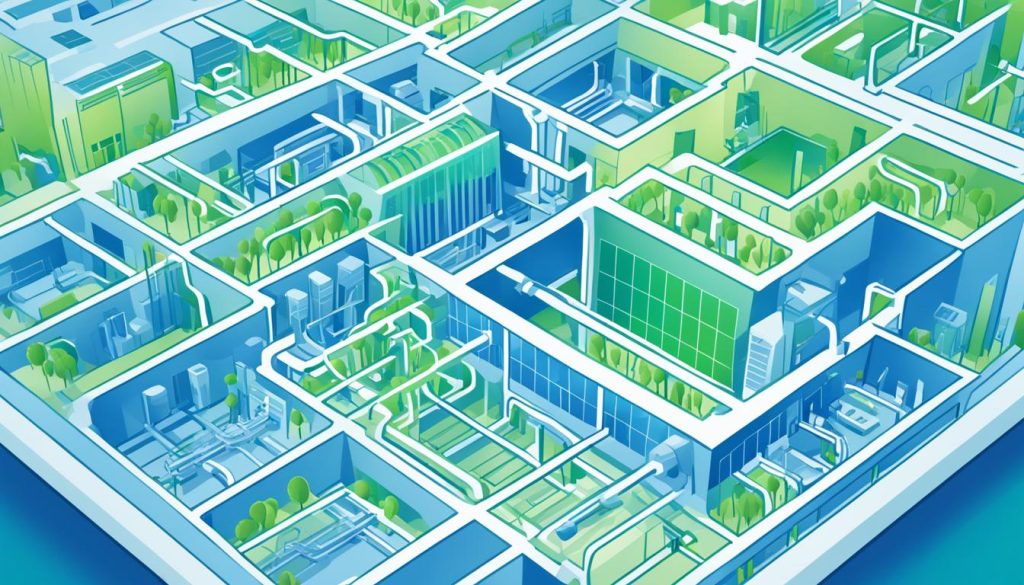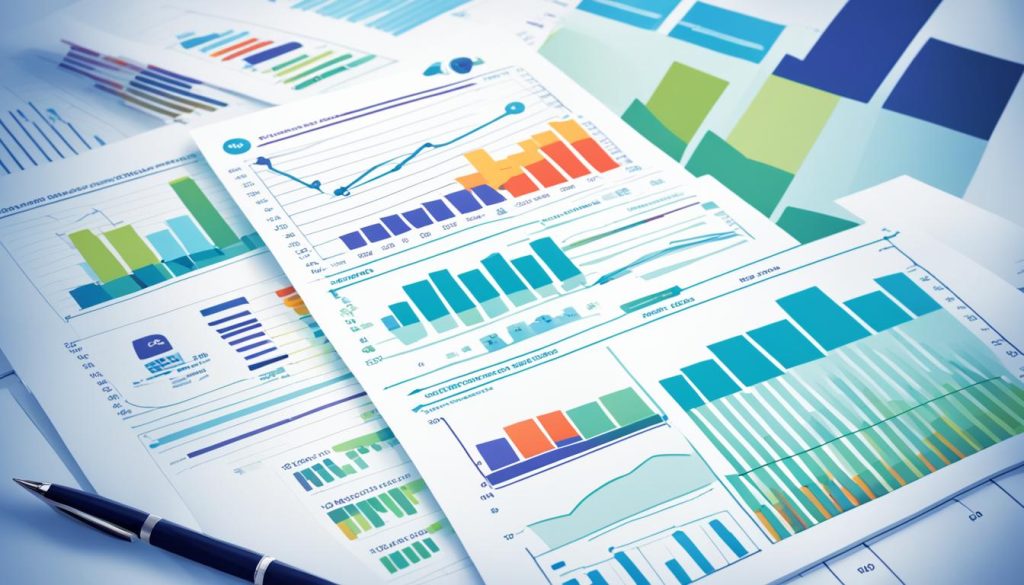To get the most from HVAC load calculation software, use it well, take advantage of its advanced features, and link it with your current systems. This approach boosts HVAC energy efficiency and improves building performance.
HVAC software is changing how we manage smart buildings. It fixes inefficiencies, handles more energy loads, and cuts down on operating costs. Using these tools gives you an edge in being sustainable and efficient in operations.
Optimizing HVAC load calculations means big energy savings and better comfort. It helps size equipment right, cutting down on unnecessary costs and boosting system performance. By focusing on HVAC software ROI, you make smart choices that help your profits and the planet.
Understanding HVAC Load Calculation Software
HVAC Load Calculation Software is key for designing efficient heating, ventilation, and air conditioning systems. It helps engineers and contractors figure out the right size and capacity for HVAC equipment in buildings. Let’s dive into the main parts of this software and how it affects HVAC System Performance.
What is HVAC Load Calculation Software?
This software is a special program that calculates heating and cooling loads for different buildings. It looks at building size, orientation, insulation, and local climate. With these details, it finds the best HVAC system for a space.
Key Features of Effective HVAC Software
Good HVAC Load Calculation Software has several key features:
- User-friendly interface for easy navigation
- Customizable inputs for various building types
- Error-checking to make sure calculations are right
- Energy-saving tips for better system design
- Works with Building Information Modeling (BIM) software
Benefits of Using Load Calculation Software
Using HVAC Load Calculation Software brings many benefits:
| Benefit | Impact on HVAC System Performance |
|---|---|
| Accurate equipment sizing | Prevents over or undersizing, leading to optimal energy use |
| Improved energy efficiency | Reduces operational costs and environmental impact |
| Data sharing and collaboration | Enhances project coordination and reduces errors |
| Time-saving calculations | Speeds up design process and increases productivity |
By using these benefits, HVAC pros can boost system performance and give more value to their clients.
The Impact of Accurate Load Calculations on HVAC Efficiency
Getting accurate load calculations is key to making your HVAC system more energy efficient and saving money. By doing precise calculations, you’re making sure your HVAC system works well for your needs.
Load calculations figure out the right size of HVAC equipment for your space. It’s important because a system that’s too big or too small can waste energy and make you uncomfortable. Here are the perks of getting load calculations right:
- Optimal system performance
- Reduced energy consumption
- Improved indoor comfort
- Extended equipment lifespan
- Compliance with building codes
When your HVAC system is the right size, you won’t have problems like short cycling or not enough cooling and heating. This means you’ll save money over time. Programs like MassSave and NYSERDA need accurate load calculations to join in.
| Impact Area | With Accurate Calculations | Without Accurate Calculations |
|---|---|---|
| Energy Consumption | Optimized | Excessive |
| System Lifespan | Extended | Reduced |
| Comfort Levels | Consistent | Fluctuating |
| Operating Costs | Lower | Higher |
Choosing accurate load calculations is a wise choice for anyone wanting to boost HVAC energy efficiency and save money over time. It’s a crucial step in making your indoor space comfortable, efficient, and green.
Selecting the Right HVAC Load Calculation Software for Your Business
Choosing the right HVAC load calculation software is key to smart HVAC Software Investment Strategies. It greatly affects HVAC Operational Efficiency. So, it’s vital to think carefully about this choice.
Assessing Your Business Needs
First, look at what you really need. Think about the types of projects, the size of your team, and what features you want. Do you need complex modeling or just basic load calculations? Figuring this out will help you pick the right software.
- Project complexity
- Team expertise
- Integration with existing systems
- Scalability for future growth
Comparing Software Options
After knowing what you need, start looking at software options. Find ones that fit your HVAC Software Investment Strategies. Check out their features, what users say, and their reputation in the industry.
| Software | Key Features | User Rating | Price Range |
|---|---|---|---|
| HVAC-Calc | 3D modeling, energy analysis | 4.5/5 | $500-$1000 |
| CoolCalc | Cloud-based, mobile app | 4.2/5 | $200-$500 |
| ThermoSim | BIM integration, advanced reporting | 4.7/5 | $1000-$2000 |
Evaluating Cost vs. Functionality
Find a balance between cost and what the software can do to boost HVAC Operational Efficiency. Some software might be cheaper but miss key features. Others could be more expensive but have too much for your needs. Think about the long-term benefits and potential return on investment.
The best software should make your work easier, more accurate, and more efficient. Try out free trials to see which options work best for you before buying.
Implementing HVAC Software: Best Practices for Smooth Integration
Getting your HVAC software to work smoothly is key to better system performance. Here are some top tips for a smooth integration.

First, check out your current systems. See what tools your team uses for building and energy modeling, and project management. This helps pick software that fits well with what you already have, making the switch easier.
Then, make sure your staff is trained. Good training is essential for using HVAC software well. Look for software providers that offer detailed training. This could be through videos, webinars, or workshops. The aim is to make your team feel ready and confident with the new tools.
When choosing software, look for easy-to-use interfaces. A design that’s easy to navigate makes it quicker to learn and use. Also, make sure it works on different devices like tablets and smartphones. This lets your team access the software anywhere, making them more productive.
| Integration Factor | Impact on HVAC System Performance |
|---|---|
| Software Compatibility | Ensures seamless data flow between systems |
| Staff Training | Improves efficiency and accuracy of calculations |
| User-Friendly Interface | Reduces errors and increases user adoption |
| Multi-Device Support | Enhances accessibility and real-time updates |
Remember, making HVAC software work well is an ongoing task. Always check how your system is doing and ask your team for feedback. This helps you find ways to get better and make sure the software keeps up with your needs.
Maximize ROI on HVAC Load Calculation Software Investments
Investing in HVAC load calculation software can boost your business efficiency a lot. To make the most of your investment, focus on HVAC Software ROI and HVAC Load Calculation Optimization. Let’s look at strategies to increase your return on investment.
Optimizing Software Usage
To get the best from your HVAC software, start by exploring all its features. Many users only use a little of what their software offers. Spend time learning about tools you might not know about. These could include automated report generation or custom templates for common calculations.
Leveraging Advanced Features
Advanced features can make your business stand out. Look for things like energy modeling to design more efficient systems. Some software lets you quickly make professional proposals. Integrating with other business tools, like project management, can boost productivity even more.
Monitoring and Analyzing Performance Metrics
Keeping an eye on how well your software is doing is crucial. Track things like time saved, how accurate you are, and how many sales you make. This info helps you see where you can get better and make sure your software is doing what it should.
Think about making a dashboard to see these metrics easily. This way, you can quickly spot trends and make smart choices.
| Metric | Before Software | After Software | Improvement |
|---|---|---|---|
| Time per calculation | 2 hours | 30 minutes | 75% reduction |
| Accuracy rate | 85% | 98% | 13% increase |
| Projects completed monthly | 20 | 35 | 75% increase |
By focusing on these areas, you can greatly increase your HVAC Software ROI. Remember, success comes from always learning and adapting to new features and trends.
Training Your Team: Ensuring Efficient Software Utilization
Effective HVAC Software Training is key to getting the most out of your load calculation tools. It helps your team use the software better, making your HVAC operations more efficient. This means you’ll see a quicker return on your investment.
Begin by creating a detailed training plan that covers everything about the software. Include basic use, advanced features, and the best ways to use it every day. Many HVAC software providers have training resources you can use as a starting point.
Think about a step-by-step training plan:
- Basic training for all staff members
- Advanced courses for power users
- Specialized sessions for specific roles or departments
It’s important to have hands-on practice for learning. Create test areas where your team can try out the software safely. This helps them become confident and skilled without any risks.
To keep your team efficient, have regular training and updates on new features. This keeps their skills up to date and helps them adjust to software changes. Consider having internal champions who can offer daily support and share tips with others.
The main aim of HVAC Software Training is to empower your team. It’s not just about learning how to click buttons. It’s about using the software to improve your HVAC operations in new and creative ways.
Integrating HVAC Software with Existing Systems
HVAC Software Integration is crucial for better HVAC System Performance. It connects your HVAC software with other tools for a unified workflow. This boosts efficiency and accuracy. Let’s see how to link HVAC software with your current systems.
Compatibility with BIM Software
Linking HVAC software with Building Information Modeling (BIM) tools makes design smoother. It ensures real-time updates and precise coordination between HVAC and building structures. This way, you can catch potential issues early and make smart decisions on equipment placement.
Connecting with Project Management Tools
Connecting HVAC software with project management platforms keeps everyone in sync. You can track progress, assign tasks, and share load calculations within your project timeline. This cuts down on misunderstandings and quickens project finish.
Syncing with Customer Relationship Management Systems
Combining HVAC software with CRM systems personalizes customer service. You can view load calculations and customer history together, offering tailored advice. This integration leads to quicker, more precise quotes and happier customers.
| Integration Type | Benefits | Impact on HVAC System Performance |
|---|---|---|
| BIM Software | Improved design accuracy, clash detection | Optimized system layout, reduced rework |
| Project Management Tools | Better team coordination, streamlined workflows | Faster project completion, fewer errors |
| CRM Systems | Personalized customer service, quicker quotes | Increased customer satisfaction, better system recommendations |
By focusing on these integrations, you’ll build a strong ecosystem for your HVAC operations. Remember, successful integration needs careful planning and might require IT support for smooth data flow between systems.
Measuring the Financial Impact of HVAC Software Implementation
Understanding the financial benefits of HVAC software is key. By looking at important metrics, you can see how this tech adds value to your business. This helps you justify spending on it.

- Time saved on load calculations
- Reduction in errors and callbacks
- Improved energy efficiency in designed systems
- Increased sales conversion rates
- Enhanced customer satisfaction
By keeping an eye on these metrics, you can figure out both direct and indirect savings. Let’s dive into a sample ROI analysis:
| Metric | Before Software | After Software | Annual Savings |
|---|---|---|---|
| Time per calculation | 2 hours | 30 minutes | $10,000 |
| Error rate | 5% | 1% | $15,000 |
| Energy efficiency | 85% | 92% | $20,000 |
| Sales conversion rate | 20% | 25% | $50,000 |
| Total Annual Savings | $95,000 |
This example highlights big savings and better efficiency. With an initial cost of $30,000, the ROI in the first year would be 216%. Keep in mind, your actual results will depend on your business specifics.
Future-Proofing Your HVAC Software Investment
Being ahead in the HVAC industry means making smart software choices. Future-proofing your software keeps you competitive and boosts efficiency. Let’s look at ways to keep your HVAC software up-to-date and effective.
Staying Updated with Software Upgrades
Regular updates are key for top performance. They bring new features, fix bugs, and boost security. Set up updates to happen automatically or check for new versions often. This keeps your HVAC software modern and safe.
Adapting to Industry Changes
The HVAC world is always changing. Keep up with new rules, energy standards, and tech. Go to industry events, join groups, and talk with others. This info helps you make smart choices about your software.
Exploring Emerging Technologies in HVAC Software
Jump on new tech to boost your HVAC work. Check out these trends:
- Artificial Intelligence (AI) for predictive maintenance
- Internet of Things (IoT) for remote system checks
- Machine Learning for saving energy
- Cloud-based solutions for easy access
- Building Information Modeling (BIM) for detailed designs
Using these techs can make your HVAC work better and smoother. Aim for software that grows with your business and keeps up with changes.
| Technology | Benefits | Impact on HVAC Efficiency |
|---|---|---|
| AI-powered software | Predictive maintenance, fault detection | Reduces downtime, improves system lifespan |
| IoT integration | Real-time monitoring, remote control | Optimizes energy usage, enables quick response |
| Machine Learning algorithms | Energy consumption analysis, optimization | Lowers energy costs, improves sustainability |
| Cloud-based solutions | Anywhere access, data centralization | Enhances collaboration, streamlines workflows |
| BIM integration | Comprehensive design, clash detection | Reduces errors, improves project efficiency |
Conclusion
Investing in HVAC load calculation software changes the game for businesses. It helps boost efficiency and cut costs. By picking the right software and using it smartly, you can see big gains.
This technology lets you design better systems, save energy, and keep customers happy. To get the most out of your investment, focus on proper use and constant improvement. Train your team well and keep up with software updates.
This way, you’ll boost your HVAC operational efficiency and stay ahead in the market. The benefits aren’t just about better operations. You’ll also help the environment and offer great service to your clients.
As the HVAC industry changes, having strong software tools will give you an edge. Embrace this technology, and watch your business grow and succeed in the changing HVAC world.





0 Comments